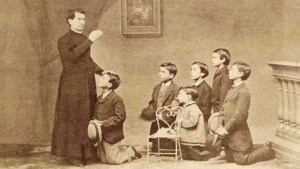Lenten Campaign 2025
This content is free of charge, as are all our articles.
Support us with a donation that is tax-deductible and enable us to continue to reach millions of readers.
It’s not easy to find the right words to talk to your child about the big questions of life and love. Should you give a fanciful explanation? Or use clear, realistic language? Inès Pélissié du Rausas — wife, mother of five, and doctor of philosophy — has studied emotional education for several years and gives concrete answers to this question in her latest book, Talking to children about love (Parlons d’amour à nos enfants in the original French).
Answering the question “How do we make babies?” means revealing “a very beautiful secret—that of the life and origin of a child,” she writes. It means “introducing children little by little to a mystery that surpasses them.” This requires parents to give careful thought to their choice of words and how they approach the subject.
A new necessity
The first step is to be honest and straightforward. Because of the availability of pornography and the tragic fact that children may be exposed to it earlier and earlier, the author recommends always using the proper, scientific names for human genitals. Children should understand their bodies as good and created by God. The objective is to “wrap them in beauty, to give them all their nobility,” showing that bodies don’t belong to the pornographic vocabulary that degrades them.
Parents can further protect their children from exposure to inappropriate topics by taking the initiative in discussing sexuality, instead of waiting for the child to ask. “Taking the initiative helps children avoid the shyness and embarrassment that make them uncomfortable or make them suspect that the subject is delicate or even taboo,” says Inès Pélissié du Rausas.
Base your explanation on your child’s experience
Taking the initiative sounds good, but what can we say? The author proposes using analogies, which makes it possible to explain to children a reality that is still unknown or confusing to them by comparing it to another reality with which they’re already familiar. Talking about sperm and ova is too abstract for young children, and too far removed from their reality. But based on their experience, such as observing the seeds that grow in nature, they know that a seed can germinate and produce a flower, a bean, or a stalk of wheat. “They will then be able to understand the analogy between seeds in general and the ‘seeds of life’ of the father and mother, which, after coming together, will become a little baby, capable of developing in the ideal environment of the mother’s womb,” she explains.
What to avoid
Inès Pélissié du Rausas urges parents to banish the expression “make babies” from their vocabulary, because it’s “devoid of transcendence and poetry.” It leads to a mechanistic idea of sexuality, one devoid of meaning, of love, and of the awareness that life is a gift. “Children are human persons and are not manufactured,” she says.
Above all, the author encourages parents to tell the truth. In an effort to preserve their children’s innocence, some parents may tell fanciful stories about storks or cabbage patches. “The problem is that this type of story is a lie,” she says. “When children then come face to face with lewd conversations and explicit content, they won’t be equipped to resist or reject this content. Not to mention that they may no longer trust their parents.”
While the comparison with nature and animals is good and easy, it has its limits. It must be explained in union with human love. “We have to transmit to our children the mystery of love between people, the story of human sexuality. Animal reproduction doesn’t help us get close to that discussion.”

Read more:
Hey, new dads, your baby’s infancy is your time to shine

Read more:
7 Saintly tips on how to discipline a child, from Don Bosco

